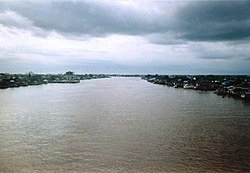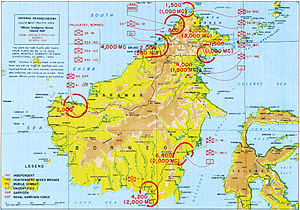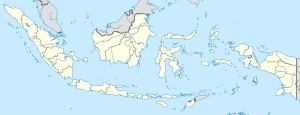Kapuas River
| Kapuas River | |
|---|---|
 | |
| Physical characteristics | |
| Mouth | South China Sea |

The Kapuas River (or Kapueas River) is a river in the Indonesian part of Borneo island, at the geographic center of Maritime Southeast Asia. With the length of 1,143 kilometers (710 mi) it is the longest river of Indonesia[1][2] and one of the world's longest island rivers.[3] It originates in the Müller Mountain Range at the center of the island and flows west into the South China Sea creating an extended marshy delta. The delta is located west-southwest of Pontianak, the capital of West Kalimantan province.[4] This Kapuas River should be distinguished from another Kapuas River, which starts on the other side of the same mountain range in central Borneo, but flows to the south, merges with the Barito River and empties to the Java Sea.
Geography and hydrology
The river is 1,143 km (710 mi) long and up to 700 m (2,300 ft) wide at its delta;[3] with the total area of 98,749 km², the river basin covers more than 67% of West Kalimantan.[5][2] The discharge rate varies through the year around the average values of 6,000–7,000 m³/s at the delta and 2,000 m³/s upstream, at confluence of Tawang River. The discharge peaks during the rainy seasons in April and November when the water level may rise by 10–12 m overnight, overflowing river banks and flooding the nearby areas.[6][2][7]
The river originates near the center of Borneo, south from the Indonesian-Malaysian border, in the joint of the western slope of the Müller Mountain Range, which runs through the island center, and the southern slope of the Upper Kapuas Range (Indonesian: Kapuas Hulu) which is located more to the west. For about 165 km it flows through a mountainous terrain and then descends to a marshy plain.[6] There, the elevation decreases by only 50 meters (160 ft) over 900 km (560 mi) from Putussibau to the river delta.[8] About 350 km from the source, near the northern shore of the river, lies a system of Kapuas Lakes which is connected to the river with numerous channels. These lakes are Bekuan (area 1,268 hectares), Belida (600 ha), Genali (2,000 ha), Keleka Tangai (756 ha), Luar (5,208 ha), Pengembung (1,548 ha), Sambor (673 ha), Sekawi (672 ha), Sentarum (2,324 ha), Sependan (604 ha), Seriang (1,412) Sumbai (800 ha), Sumpa (664) and Tekenang (1,564 ha).[9] When the monthly precipitation exceeds about 300 mm, the river overflows its banks, diverting much of its waters to the lakes at a rate of up to 1,000 m³/s, and forming a single water mass with them. This outflow prevents massive flooding of the lower reaches of the river; it also promotes fish migration from the river to the lakes for spawning, but drives away the birds from the lakes.[7]
The river discharges into the South China Sea creating a marshy delta, which spreads both inland and into the sea, with the silt deposits extending up to 50–60 km from the island shore.[8] The delta is located west-southwest of Pontianak, the capital of West Kalimantan province which lies at the equator.[10] The delta has five arms, of which the northernmost one is the widest, and is therefore called the Big Kapuas (Indonesian: Kapuas Besar). The largest tributary is the Melawi River, which occurs to the left near the city of Sintang, about 465 km from the mouth. Other major tributaries are Landak, Kubu, Punggur and Sekayam.[10]
Climate
The climate is warm and very humid, with the average annual precipitation ranging from year to year between 2,863 and 5,517 mm, and the number of rainy days between 120 and 309; the largest precipitation was observed in 1976 (120 rainy days) and the wettest in 1988, with only 184 rainy days.[5] The temperature is rather stable with a typical minimum of 24 °C (75 °F) and maximum of 32 °C (90 °F) through the whole year.[11]
Flora and fauna
In the upper and middle reaches, the river flows through dense tropical forests; the forests are rich in flora and fauna and are the subject of international research.[5] Discoveries of new species are frequent, such as of the Kapuas mud snake (Enhydris gyii) in 2003–2005 by the German and American herpetologists. This species is remarkable by spontaneously changing their skin color, similar to the chameleon.[12][13]

About 300 fish species have been identified in the river, of which 234 are of high economical value.[1] They belong to 120 genera and 40 families with the two major groups being carp and catfish. More than 30% of the species originate from the sea and inhabit the delta areas.[14] Owing to warm climate and abundance of food, most fishes breed all through the year with only a few species like fire eel (Mastacembelus erythrotaenia) having certain reproduction periods. The number of individuals per species is relatively low. The large variety of species may be explained by the fact that some 6,000 years ago, the Kapuas River was connected to the rivers of South Sumatra, Java and Malay Peninsula. Apart from fish, there are numerous crabs, prawns, water striders and other aquatic insects.[15] The rich flora and fauna results in very complex food chains, with fishes consuming foods ranging from fruits to other fish. For example, Hemirhamphodon pogonognathus eats exclusively terrestrial insects. The abundant fruits and seeds originate in the river from large trees bending over its waters.[16] The fish feeding habits in the Kapuas River are distributed as follows: 54% are omnivores; 36% are carnivorous and eat other fish (14%), insects (5%) and mixed small forest animals (17%). The remaining 10% are herbivorous, with 4% of them specialazing in algae.[17]

Otters and crocodiles are common in the Kapuas River, but frogs are nearly absent.[17] Agile Gibbon (Hylobates agilis), Müller's Bornean Gibbon (Hylobates muelleri), Prevost's Squirrel (Callosciurus prevostii) and treeshrews inhabit the trees above the river.[18]
There are two national parks on the river banks, Betung Kerihun with the area of 8,000 km² and Danau Sentarum (area 1,320 km²), the latter includes the Kapuas Lakes.[5][19]
Transport and economic value
The Kapuas River is the major waterway connecting the central of the island with its western coast. The large river width and depth (up to 27 meters[3]) support intensive cargo and passenger shipping over most of the river length. Ships with the draft of up to 3 meters can navigate up to Sintang, 465 km from the mouth, and with a draft up to 2 meters up to the city of Putussibau (902 km from the mouth). Logging and rafting of the logs are practiced all along the river. Also common is fishing, especially at the Kapuas Lakes and near the river delta.[6][20]
References
- ^ a b Friedhelm Göltenboth Ecology of insular Southeast Asia: the Indonesian Archipelago, Elsevier, 2006, ISBN 0444527397 p. 157
- ^ a b c MacKinnon, p. 133
- ^ a b c Noni Arnee. "Pesona di Bawah Garis Katulistiwa" (in Indonesian). Suara Merdeka. Retrieved 22 марта 2010.
{{cite web}}: Check date values in:|accessdate=(help); Unknown parameter|datepublished=ignored (help) - ^ Kapuas River, Encyclopedia Britannica on-line
- ^ a b c d "Betung Kerihun National Park (Transborder Rainforest Heritage of Borneo)". UNESCO World Heritage Centre. 2 February 2004 года.
{{cite web}}: Check date values in:|date=(help) - ^ a b c Great Soviet Encyclopedia. Vol. 11. Moscow. 1969–1978. p. 367.
{{cite book}}: CS1 maint: location missing publisher (link) reduced electronic version - ^ a b MacKinnon, p. 160
- ^ a b MacKinnon, p. 131
- ^ MacKinnon, pp. 152, 159
- ^ a b South Kalimantan
- ^ Pontianak, Borneo Climate
- ^ John C. Murphy; Harold K. Voris; Mark Auliya (2005). "A new species of Enhydris (Serpentes: Colubridae: Homalopsinae) from the Kapuas river system, West Kalimantan, Indonesia" (PDF). The Raffles Bulletin of Zoology. 53 (2): 271–275.
{{cite journal}}: CS1 maint: multiple names: authors list (link) - ^ "Snake displays changing colours". BBC News. 26 June 2006. Retrieved 2007-01-09.
- ^ MacKinnon, p. 143
- ^ MacKinnon, p. 132
- ^ MacKinnon, p. 161
- ^ a b MacKinnon, p. 162
- ^ MacKinnon, pp. 52–53
- ^ Elizabeth Linda Yuliani, Yayan Indriatmoko, Seselia Ernawati, Leon Budi Prasetyo, Zul MS. "Promoting Good Governance in Danau Sentarum National Park under Decentralization" (PDF).
{{cite web}}: Unknown parameter|datepublished=ignored (help)CS1 maint: multiple names: authors list (link) - ^ MacKinnon, p. 457
Bibliography
- MacKinnon, Kathy The ecology of Kalimantan, Oxford University Press, 1996, ISBN 0945971737
-0.266006°N 109.875412°E / 0.266006°S 109.875412°E Coordinates: latitude degrees < 0 with hemisphere flag
{{#coordinates:}}: invalid latitude

